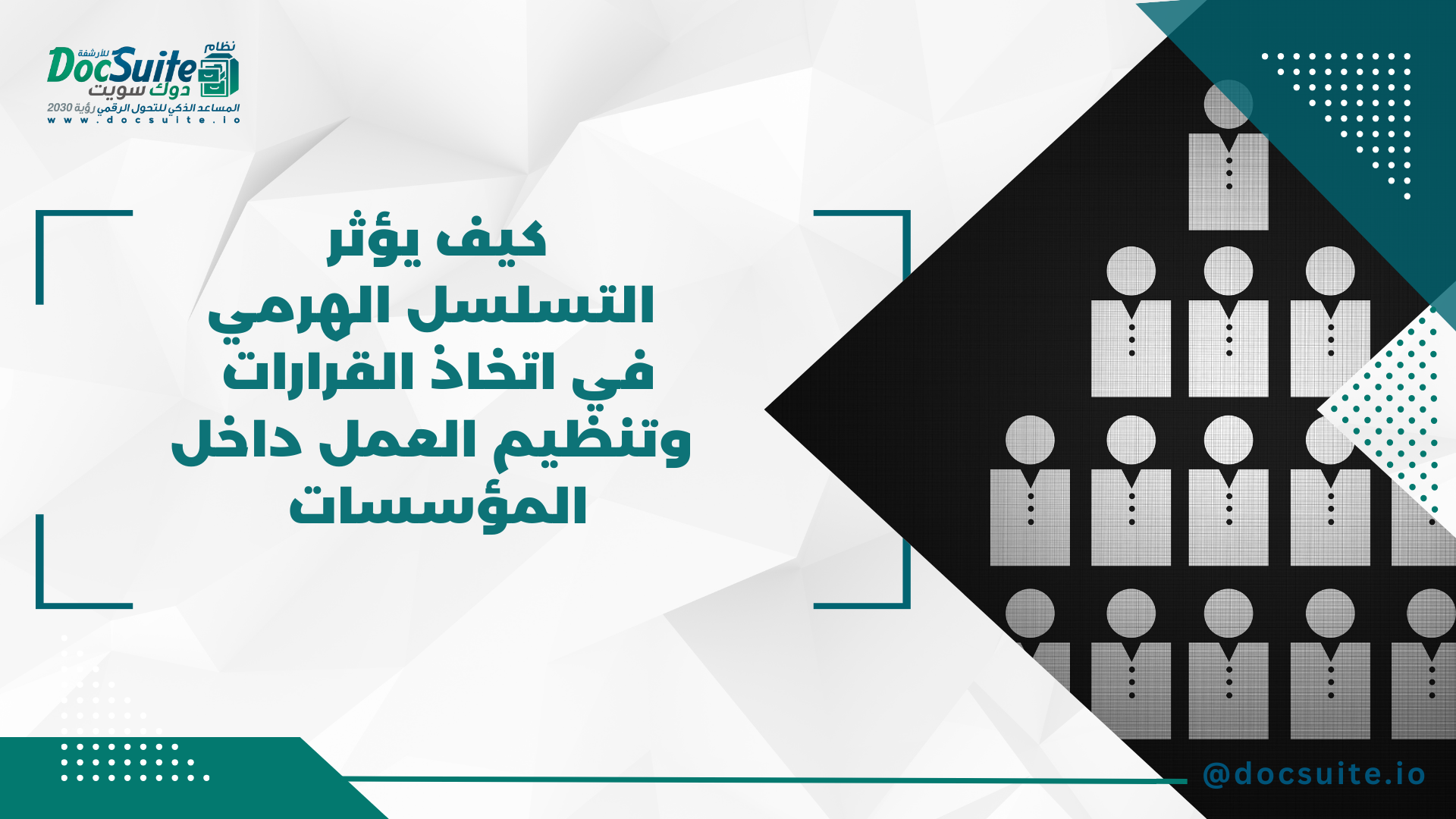Organizations and businesses strive for continuous modernization to balance their internal structures and direct their activities towards achieving desired goals. In this complex context, the hierarchical management structure stands out as one of the leading patterns in the management world, characterized by a hierarchical arrangement that gradually directs authority and responsibilities from the top down.
DocSuite's system seamlessly integrates with administrative organizational structures, enhancing the effectiveness of the hierarchical management structure. With its advanced electronic means, the system provides superior facilities for managing and exchanging information, thereby improving communication and reflecting effective interactivity between different management levels.
.png) What is a Hierarchical Organizational Structure?
What is a Hierarchical Organizational Structure?
In the field of business management, the pyramid structure emerges as one of the most classic and effective ways to organize hierarchical management and direct it towards achieving its objectives. The pyramid structure fundamentally represents a hierarchical organization that relies on a gradual sequence in distributing authority and responsibilities within the organization, seamlessly integrating with management processes.
The pyramid structure is characterized by precise and gradual organization, where the administrative structure is arranged hierarchically. The company's top leadership is at the peak, with other administrative layers progressively involved downwards, facilitating an easy understanding of the organizational structure.
Clear Authority Sequence:
The pyramid structure clearly defines the sequence of authority, with the upper layers having the authority to make key decisions, while the lower layers play an executive role for the top leadership's directives.
Efficient Decision-Making:
The pyramid structure enables high effectiveness in decision-making, where the organization is clear, and decisions are made quickly, enhancing the company’s response to challenges and opportunities.
Performance Monitoring:
The pyramid structure provides ease in monitoring performance and supervising different administrative levels, facilitating the provision of necessary guidance and support.
Employee Motivation:
The pyramid structure effectively directs and motivates employees, as each individual knows their role and responsibilities within the administrative structure, contributing to enhanced performance.
Challenges in Adaptation:
However, the pyramid structure faces challenges in adapting to rapid changes in the operational environment, where bureaucracy can be an obstacle in some volatile industries.
Lack of Flexibility:
The pyramid structure may lack flexibility in dealing with unforeseen challenges, as bureaucracy can be a hindrance in some cases.
.png)
 Role of DocSuite in Managing Hierarchical Structures in Companies
Role of DocSuite in Managing Hierarchical Structures in Companies
The integration of the HR management system with electronic management systems like DocSuite represents a vital tool for enhancing the effectiveness of hierarchical structures. This type of system allows for easy organization and updating of employee data, including tasks, responsibilities, and job levels, facilitating effective and efficient management of the hierarchical structure.
Ease of Electronic Access and Exchange:
DocSuite allows effective integration between teams within the organization by facilitating communication and document sharing. Teams can use internal messages within the system to interact, enhancing collaboration and improving understanding of shared tasks and projects. These details and messages are easily accessible, enhancing the team's understanding of the current situation and facilitating effective strategic decision-making.
Improving Transparency and Communication:
DocSuite helps reduce communication gaps and improve awareness among different teams and departments. With quick and easy access to important documents and data, this system reduces the likelihood of misunderstandings and improves the quality of decisions made within the organization, promoting positive interaction and building a work environment that encourages cooperation and innovation.
Facilitating Guidance and Delegation Processes:
DocSuite aids in facilitating HR management and hierarchical organization processes, allowing top leadership to issue directives effectively. This system enables directing efforts and ensuring precise and effective implementation of decisions, contributing to enhancing work efficiency and achieving institutional goals more swiftly and effectively.
Enhancing Efficiency and Productivity:
The workflow management feature in DocSuite stands out as a key tool for improving efficiency and boosting productivity. By facilitating information exchange between administrative levels, the system effectively organizes workflow, enhancing coordination between different teams and departments. Users can use the workflow management interface to see specified tasks, track work progress, and identify key tasks, simplifying collaboration and interaction among employees, enhancing goal comprehension and task requirements. Workflow management allows users to exchange information effectively and improve work directives, positively impacting integration and efficiency in achieving institutional goals.
Document Preservation and Protection:
The integrated HR management system with organizational structure plays a crucial role in preserving and protecting important documents. For example, this system can provide secure storage for documents and protect them effectively through advanced security settings, ensuring the confidentiality and integrity of sensitive information for employees and the company.
.jpg) Advantages of Hierarchical Management
Advantages of Hierarchical Management
In improving institutional performance and achieving effective integration within their organizational structures, companies adopt organizational patterns that align with their goals and needs. Among these patterns, the hierarchical management structure stands out as one of the most classic and effective ways to organize work and direct it towards achieving its objectives. Here, we explore the advantages of hierarchical management structure through three main points:
Clarity of Authority and Responsibilities:
The hierarchical management structure provides a clear framework that defines the authority and responsibilities of each individual within the organization. This arrangement helps in defining the communication and delegation chain, enhancing transparency and improving overall work effectiveness and organization.
Strategic Decision-Making:
As a hierarchical management pattern, this approach enables effective strategic decision-making by the top leadership. It allows the organization to set major goals and develop strategies to achieve them, contributing to integration and harmony in work.
Effective Work Distribution:
The hierarchical management structure allows for easy delegation of tasks and responsibilities across different management levels. This effective distribution of work achieves optimal organization and increases productivity, as the team benefits from clear and direct directives, enhancing cooperation and interaction among members.
Challenges of Hierarchical Management
Challenges of hierarchical management are an important topic that necessitates deep thinking about how to improve the effectiveness of the organizational structure in institutions. Highlighting these challenges contributes to a better understanding of the potential difficulties faced by companies and organizations relying on hierarchical management structure.
Slow Decision-Making:
The hierarchical management structure can cause delays in decision-making processes, as decisions need to climb up the hierarchy to the top, potentially resulting in missed opportunities and delayed responses to institutional challenges.
Communication Gaps:
The hierarchical management structure can reduce the effectiveness of communication between different management levels. Official communication often occurs vertically, increasing the chances of misunderstandings and disparities in goals and strategies.
Difficulty in Adaptation
The hierarchical structure can be too traditional, making it less capable of adapting to rapid changes in the operational environment. Adaptation becomes challenging when the structure is rigid and not ready to handle external variables.
These challenges indicate the importance of considering the specific context of each organization and determining how well the hierarchical management structure fits their needs and nature of work to overcome these difficulties.
ConclusionThe effectiveness of the hierarchical management structure becomes evident, especially when integrated with modern technology like DocSuite for document and information management. This technology plays a crucial role in enhancing internal organization and improving administrative communications, significantly contributing to the success of institutions in an advanced and developed business environment. The alignment between the hierarchical structure and modern business management systems promotes effective integration, enhances efficiency, and propels institutions towards successfully achieving their goals.
